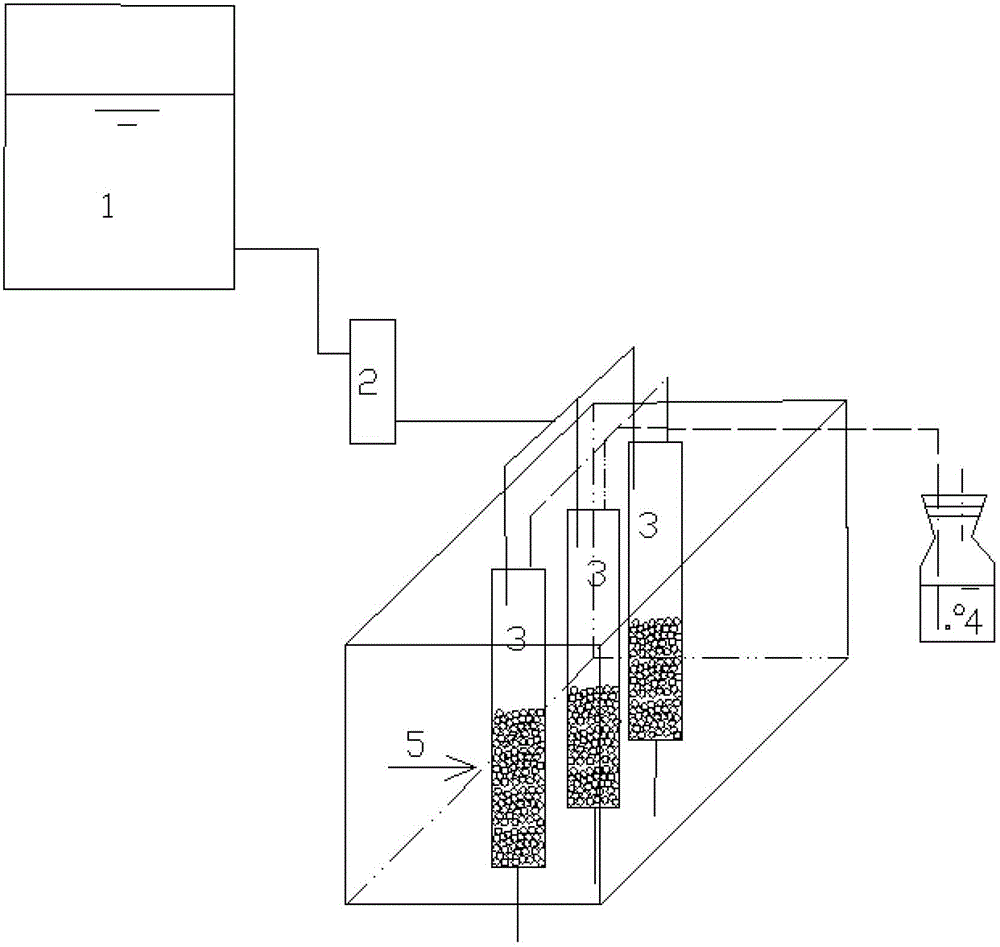Method for continuously processing degradation-resistant wastewater by means of microwave catalysis and device therefor
A technology for wastewater treatment and refractory degradation, applied in the direction of light water/sewage treatment, etc., can solve the problems of small amount of treated water, difficult solid-liquid separation, short service life of catalysts, etc., to achieve large treatment capacity, improve treatment efficiency, and increase treatment capacity Effect
- Summary
- Abstract
- Description
- Claims
- Application Information
AI Technical Summary
Problems solved by technology
Method used
Image
Examples
Embodiment 1
[0022] The walnut shell is ground and carbonized to make carbonized material, mixed with binder, shaped in a molding machine, dried and activated, and then cut into a granular activated carbon catalyst with a diameter of about 2mm.
[0023] The above-mentioned granular activated carbon catalyst is filled into a quartz tube with a diameter of 24 mm to a height of 80 mm to form a fixed bed of granular activated carbon catalyst. The fixed bed of granular activated carbon catalyst is set in a microwave field with a microwave power of 500W perpendicular to the microwave direction and the ground. Pass 2000mg / l simulated ammonia nitrogen wastewater into the fixed bed at a flow rate of 20ml / min. The concentration of ammonia nitrogen before and after treatment was measured by Nessler's reagent spectrophotometry. The concentration of ammonia nitrogen after treatment was 140mg / l, and the removal rate of ammonia nitrogen was 94%. After the same batch of granular activated carbon reacted c...
Embodiment 2
[0025] The walnut shell is ground and carbonized to make carbonized material, mixed with binder, shaped in a molding machine, dried and activated, and then cut into a granular activated carbon catalyst with a diameter of about 2mm.
[0026] The above-mentioned granular activated carbon catalyst is filled into a quartz tube with a diameter of 24 mm to a height of 80 mm to form a fixed bed of granular activated carbon catalyst. The fixed bed of granular activated carbon catalyst is set in a microwave field with a microwave power of 500W perpendicular to the microwave direction and the ground. Pass 2000mg / l simulated ammonia nitrogen wastewater into the granular activated carbon column at a flow rate of 40ml / min. The concentration of ammonia nitrogen before and after treatment was measured by Nessler's reagent spectrophotometry, and the removal rate of ammonia nitrogen was 91%.
Embodiment 3
[0028] The walnut shell is ground and carbonized to make carbonized material, mixed with binder, shaped in a molding machine, dried and activated, and then cut into a granular activated carbon catalyst with a diameter of about 2mm.
[0029] The above-mentioned granular activated carbon catalyst is filled into a quartz tube with a diameter of 24 mm to a height of 80 mm to form a fixed bed of granular activated carbon catalyst. The fixed bed of granular activated carbon catalyst is set in a microwave field with a microwave power of 800W perpendicular to the microwave direction and the ground. The actual coking wastewater was passed through the granular activated carbon column at a flow rate of 20ml / min. The concentration of ammonia nitrogen before and after the reaction was measured by Nessler's reagent spectrophotometry. The concentration of ammonia nitrogen before the reaction was 6270 mg / L, and the concentration after the reaction was 420 mg / L. The removal efficiency of ammonia...
PUM
| Property | Measurement | Unit |
|---|---|---|
| size | aaaaa | aaaaa |
Abstract
Description
Claims
Application Information
 Login to View More
Login to View More - R&D
- Intellectual Property
- Life Sciences
- Materials
- Tech Scout
- Unparalleled Data Quality
- Higher Quality Content
- 60% Fewer Hallucinations
Browse by: Latest US Patents, China's latest patents, Technical Efficacy Thesaurus, Application Domain, Technology Topic, Popular Technical Reports.
© 2025 PatSnap. All rights reserved.Legal|Privacy policy|Modern Slavery Act Transparency Statement|Sitemap|About US| Contact US: help@patsnap.com

